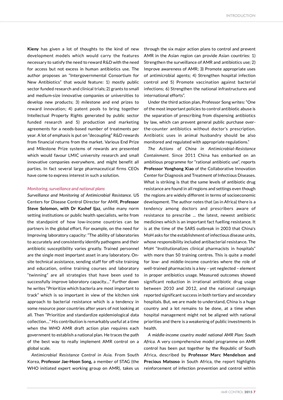
Kieny has given a lot of thoughts to the kind of new
development models which would carry the features
necessary to satisfy the need to reward R&D with the need
for access but not excess in human antibiotics use. The
author proposes an "Intergovernmental Consortium for
New Antibiotics" that would feature: 1) mostly public
sector funded research and clinical trials; 2) grants to small
and medium-size innovative companies or universities to
develop new products; 3) milestone and end prizes to
reward innovation; 4) patent pools to bring together
Intellectual Property Rights generated by public sector
funded research and 5) production and marketing
agreements for a needs-based number of treatments per
year. A lot of emphasis is put on "decoupling" R&D rewards
from financial returns from the market. Various End Prize
and Milestone Prize systems of rewards are presented
which would favour LMIC university research and small
innovative companies everywhere, and might benefit all
parties. In fact several large pharmaceutical firms CEOs
have come to express interest in such a solution.
Monitoring, surveillance and national plans
Surveillance and Monitoring of Antimicrobial Resistance. US
Centers for Disease Control Director for AMR, Professor
Steve Solomon, with Dr Kashef Ijaz, unlike many norm
setting institutions or public health specialists, write from
the standpoint of how low-income countries can be
partners in the global effort. For example, on the need for
Improving laboratory capacity: "The ability of laboratories
to accurately and consistently identify pathogens and their
antibiotic susceptibility varies greatly. Trained personnel
are the single most important asset in any laboratory. Onsite
technical assistance, sending staff for off-site training
and education, online training courses and laboratory
"twinning" are all strategies that have been used to
successfully improve laboratory capacity…" Further down
he writes "Prioritize which bacteria are most important to
track" which is so important in view of the kitchen sink
approach to bacterial resistance which is a tendency in
some resource poor countries after years of not looking at
all. Then "Prioritize and standardize epidemiological data
collection…" His contribution is remarkably useful at a time
when the WHO AMR draft action plan requires each
government to establish a national plan. He traces the path
of the best way to really implement AMR control on a
global scale.
Antimicrobial Resistance Control in Asia. From South
Korea, Professor Jae-Hoon Song, a member of STAG (the
WHO initiated expert working group on AMR), takes us
through the six major action plans to control and prevent
AMR in the Asian region can provide Asian countries: 1)
Strengthen the surveillance of AMR and antibiotics use; 2)
Improve awareness of AMR; 3) Promote appropriate uses
of antimicrobial agents; 4) Strengthen hospital infection
control and 5) Promote vaccination against bacterial
infections; 6) Strengthen the national infrastructures and
international efforts".
Under the third action plan, Professor Song writes: "One
of the most important policies to control antibiotic abuse is
the separation of prescribing from dispensing antibiotics
by law, which can prevent general public purchase overthe-counter
antibiotics without doctor's prescription.
Antibiotic uses in animal husbandry should be also
monitored and regulated with appropriate regulations."
The Actions of China in Antimicrobial-Resistance
Containment. Since 2011 China has embarked on an
ambitious programme for "rational antibiotic use", reports
Professor Yonghong Xiao of the Collaborative Innovation
Center for Diagnosis and Treatment of Infectious Diseases.
What is striking is that the same levels of antibiotic drug
resistance are found in all regions and settings even though
the regions are widely different in terms of socioeconomic
development. The author notes that (as in Africa) there is a
tendency among doctors and prescribers aware of
resistance to prescribe ... the latest, newest antibiotic
medicines which is an important fact fuelling resistance. It
is at the time of the SARS outbreak in 2003 that China's
MoH asks for the establishment of infectious disease units,
whose responsibility included antibacterial resistance. The
MoH "Institutionalizes clinical pharmacists in hospitals"
with more than 50 training centres. This is quite a model
for low- and middle-income countries where the role of
well-trained pharmacists is a key - yet neglected - element
in proper antibiotics usage. Measured outcomes showed
significant reduction in irrational antibiotic drug usage
between 2010 and 2012, and the national campaign
reported significant success in both tertiary and secondary
hospitals. But, we are made to understand, China is a huge
country and a lot remains to be done, at a time when
hospital management might not be aligned with national
priorities and there is a weakening of public investments in
health.
A middle-income country model national AMR Plan: South
Africa. A very comprehensive model programme on AMR
control has been put together by the Republic of South
Africa, described by Professor Marc Mendelson and
Professor Precious Matsoso in South Africa, the report
highlights reinforcement of infection prevention and
INTRODUCTION
AMR CONTROL 2015 7